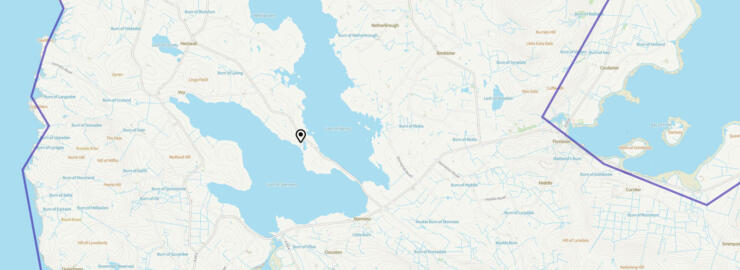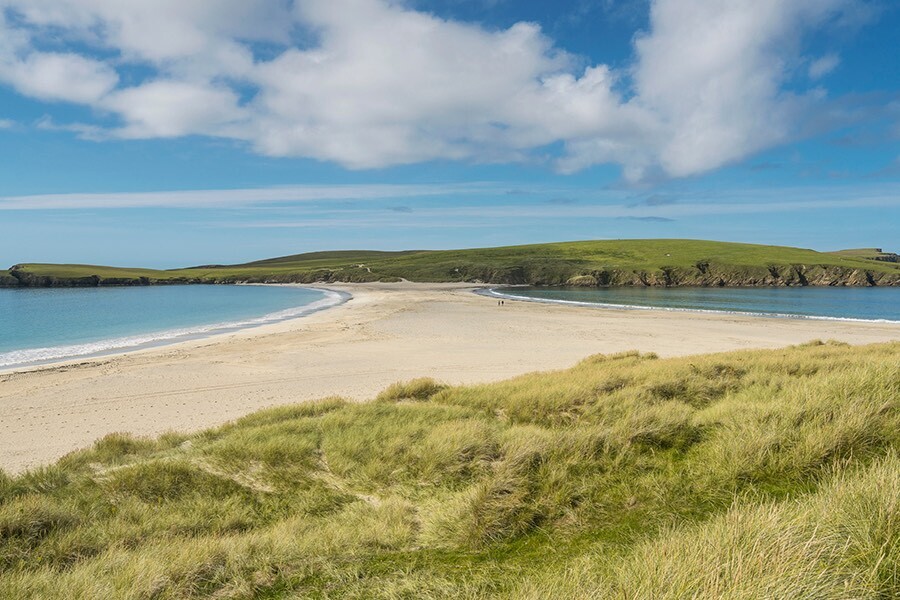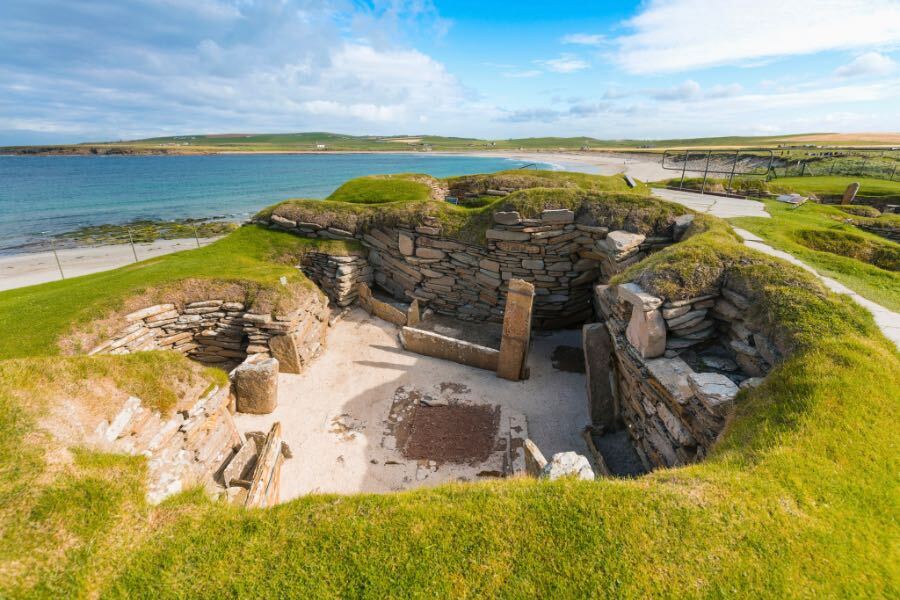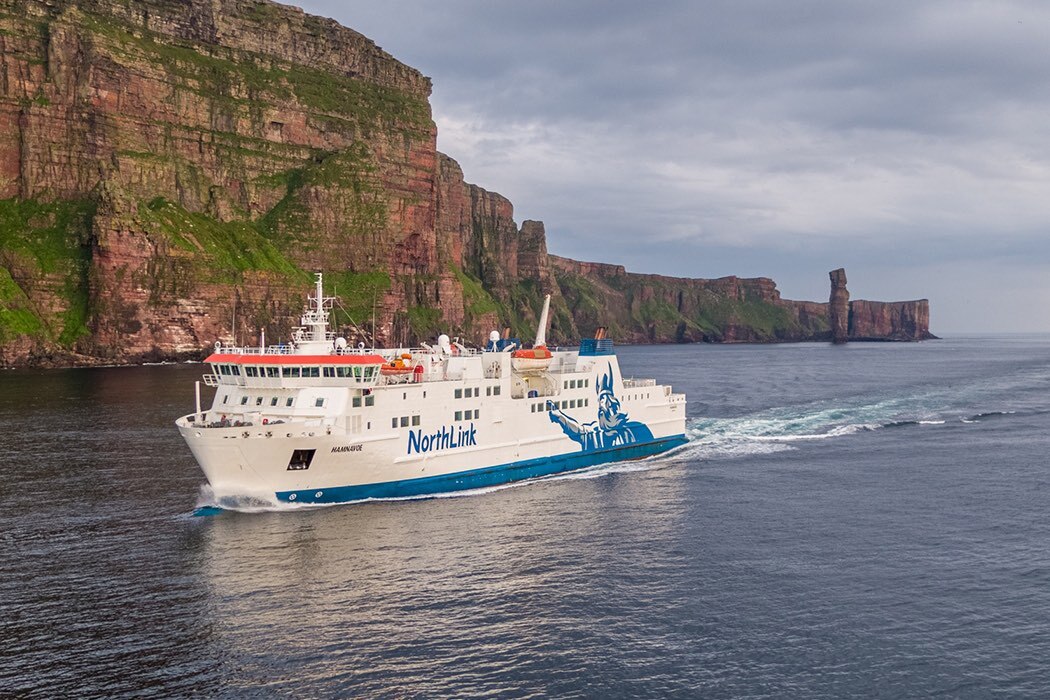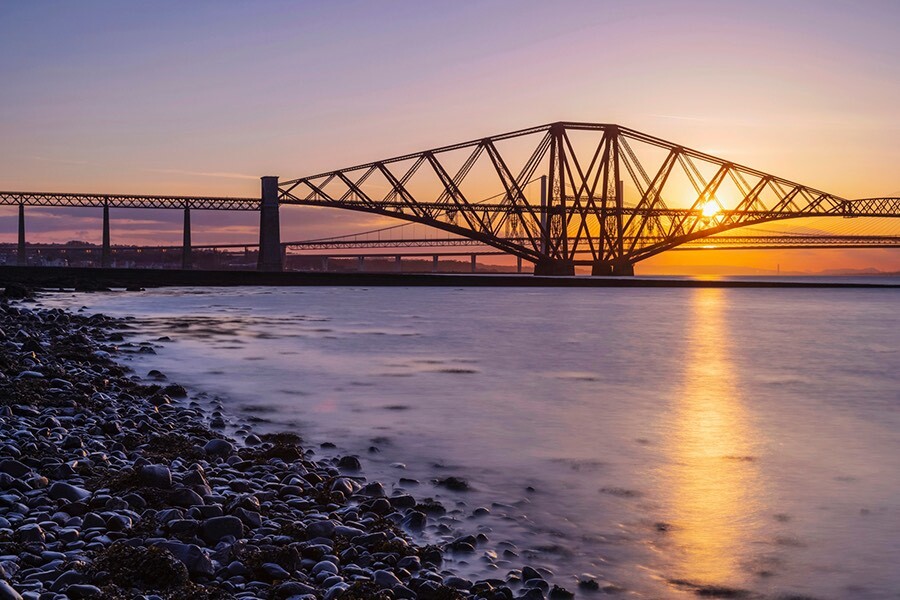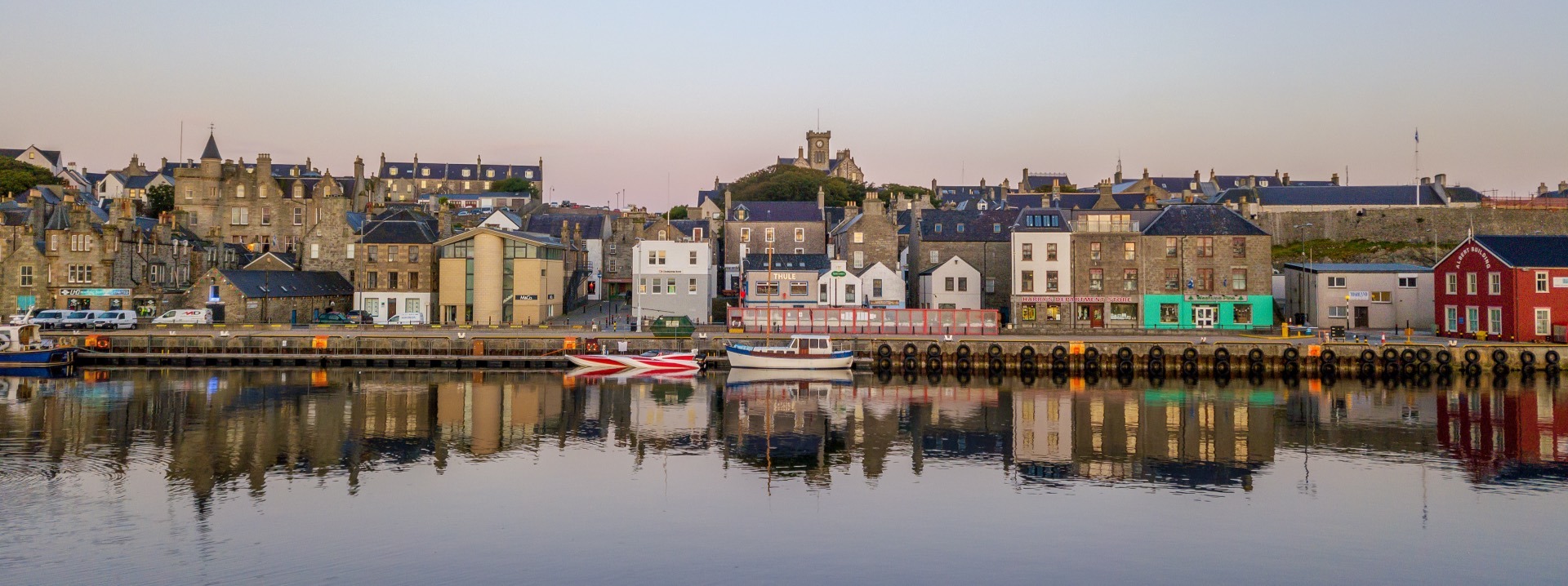
Experience The Uniqueness of UNESCO on Scotland's Northern Isles
Designations on this journey
How to get to the north islands of Scotland
You can take public transport up north to the islands – you can travel to Aberdeen and Thurso by Citylink coach* or Scotrail train, or to Gills Bay with Citylink. You can then catch the ferry over to the islands.
There are three ferry routes, with several daily sailings. Pentland Ferries from Gill's Bay to St Margaret's Hope, Orkney (one hour) is the quickest sailing, and the most environmentally-friendly passenger ferry of its type in Scotland, thanks to the new purpose-built catamaran MV Alfred.
You can also sail with NorthLink Ferries for 1.5 hours from Scrabster to Stromness in Orkney. They also sail every day to Lerwick in Shetland (taking around 12 hours), with four of those weekly routes stopping in Kirkwall, Orkney first (taking around 6 hours).
During the summer, there is a fourth ferry route for foot passengers from John O’Groats to Burwick.
Planes also fly direct to Kirkwall and Sumburgh (Shetland) airports from Glasgow, Edinburgh, Aberdeen and Inverness with Loganair, with flights around one hour.
*The Citylink bus doesn’t take you directly to the terminal. Contact iCentre for taxi details for the 2 mile journey between terminals.
Orkney has quiet roads and a good bus and inter-island ferry service, along with an inter-island air service (advance booking required) so you can reach all corners of the islands.
You can also hire a car or bicycle, book a taxi or a tour guide.
Find more on travelling to Orkney, or visiting Shetland.

Heart of Neolithic Orkney
Where to start
Orkney is an archipelago made up of around 70 islands – around 20 of those islands are inhabited. Mainland should be the starting point of your adventure, home to the capital Kirkwall and main town of Stromness. The Heart of Neolithic Orkney sits nearest Stromness in the West Mainland.
Places to base yourself
Why it’s special
The Heart of Neolithic Orkney brings together four amazing monuments which tell a remarkable story through stone. These sites are a testament to the skilled people who built them. Thanks to their talent, we are able to get incredible insights into their society and their spiritual beliefs.
Skara Brae, Maeshowe, the Stones of Stenness and the Ring of Brodgar are each uniquely important – but put them together in this incredible landscape and you have a breath-taking experience. It’s a site where you’ll want to take your time, embrace the changing light and weather, and really soak up the sense of place.
Type of designation:
World Heritage Site
How long to stay:
At least 3-4 days
What to do during your time
Things to do
Ring of Brodgar
The Ring of Brodgar is a hauntingly beautiful stone circle that is thought to have been built around 2500-2000 BC. It’s one of the largest circles of its kind in the British Isles.
This monument is massive. It originally consisted of 60 stones, and an impressive 36 remain today. There are at least 13 prehistoric burial mounds nearby while a large rock-cut ditch surrounds the stone circle.
The Scottish geologist Hugh Miller, visiting in 1846, wrote that the stones ‘look like an assemblage of ancient druids, mysteriously stern and invincibly silent and shaggy’.
The rangers are available to answer questions, and host guided walks in the summer. Or follow the paths yourself to see more, such as the Comet Stone, a monolith south-east of the stone circle.
Find out more on the Ring of Brodgar.
Skara Brae
Take a trip back in time at this stone village of nine houses. Archaeologists estimate it was built and occupied from around 3180 – 2500 BC, during the Neolithic era or New Stone Age, which makes the village older than the pyramids and Stonehenge.
Perched above the beach at the Bay of Skaill, it was discovered by a winter storm in 1850 when the sand and grass were stripped back to reveal a network of houses complete with dressers, stone beds and hearths. The houses were built from slabs of stone – surviving sections suggest the walls were up to 2.4 m and connected by covered but low and narrow passageways.
Skara Brae's remarkable survival through the ages is thanks to the original building design which buried the stone-slab walls up to roof level in clay soil and waste material to provide insulation and protection from the elements.
Explore the site to learn how Neolithic people built their homes, as well as the work they did, the tools they used, the food they ate and much, much more. Visit on a windy day for a real, invigorating Orkney experience.
Local tip: take time to explore more around the rest of Bay of Skaill which is a wonderful beach and has loads more archaeological, historical and natural heritage interest in addition to Skara Brae itself.
Plan your trip to Skara Brae.
Maeshowe
Built 5,000 years ago, Maeshowe is one of Europe’s finest chambered tombs. The entrance passage was built to align with the setting of the midwinter sun, when the light illuminates the tomb’s interior.
Norse crusaders broke into the long abandoned Maeshowe in the mid-1100s through the blocked passageway. They left their own mark as they graffitied runes all over the main chamber walls. This gives us a great insight into Norse society but doesn’t take away from the original masterpiece of Neolithic design and construction using massive stones.
The cairn is currently closed due to Covid-19 restrictions but the visitor centre is open, and there are bookable guided talks about Maeshowe and other historic sites.
Learn more about Maeshowe Chambered Cairn.
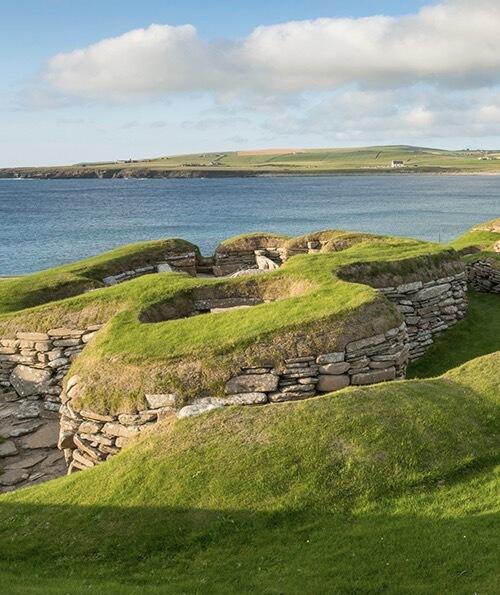
Stones of Stenness
This might be the earliest henge monument in the British Isles, built over 5,000 years ago. The Stones of Stenness are a great stone circle on an ancient ceremonial site, consisting of four upright stones up to 6 m in height.
The original circle held 12 stones, around a large hearth and encircled by a large ditch and bank, now lost to ploughing. Excavated pottery and animal bones have shown the Neolithic visitors cooked and ate food at the site.
Two nearby stones, the Watch Stone and the Barnhouse Stone, are likely to have once had a connection with this henge.
Local tip: stand in the middle of the remaining stones looking towards the huge slabs of stone and beyond across the loch and towards the hills on the island of Hoy. If you shout or clap, you’ll realise that there’s an echo thrown back at you. People thousands of years ago would have experienced the place through all their senses, including sound – perhaps with music, drumming, singing - but they will have heard that echo too.
Learn more about the Stones of Stenness.
Tour options
Lizzie’s Orkney Tours
Book the Orkney World Heritage Tour to visit all of the Heart of Neolithic Orkney or try the Pre-History Tour to visit other monuments such as the Cuween Cairn and Broch of Gurness.
Lizzie was born in Orkney and has lived here all her life. She is a Scottish Tourist Guiding Association Green Badge accredited tourist guide.
See more on Lizzie’s Orkney Tours.
Other places to visit
Rousay
Experience 5,000 years of Orcadian history in one small stretch of coastline on the outer isle of Rousay, known as the ‘Egypt of the north’! There are more than a hundred archaeological sites along Rousay, with the Westness Heritage Walk giving visitors the chance to sample the Neolithic, through the Iron Age and the Vikings, all the way to the Clearances of the 1800s.
Broch of Gurness
The Broch of Gurness in Evie has plenty of nooks and crannies to explore. This remarkably well-preserved Iron Age settlement will fascinate children and grown-ups alike.
Brough of Birsay
Discover the tidal island of the Brough of Birsay, which is accessed by causeway at low tide. Explore the remains of an ancient settlement which includes remains from Pictish, Norse and medieval times. There are craggy cliffs, a lighthouse and Atlantic Ocean views to take in as well.
Please check tide prediction times at Kirkwall iCentre or on the Orkney website when planning your trip.
The Italian Chapel
The islands were also strategically important during World War Two and stories from that time resound to this day. The Italian Chapel is a remarkable building - a Nissen hut painted to resemble a chapel by Italian prisoners of war during the conflict. This beautiful and intricate building is totally charming.
Pier Arts Centre
This 5-star arts venue is well worth a visit on a trip to Stromness. You’ll find a collection of 20th century artworks of national significance and significant contemporary artists, including Olafur Eliasson, Barbara Hepworth, Ben Nicolson and Terry Frost. Find out about upcoming exhibitions.
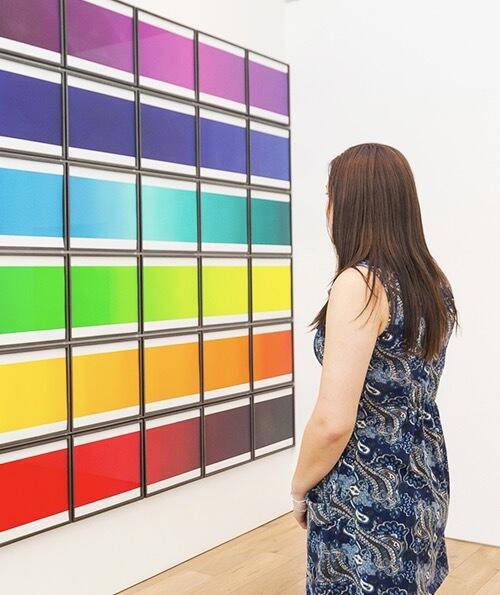
Food & drink
Orkney is famed across the world for its delicious local produce, particularly the crab, scallops, salmon, beef and lamb. New and award-winning products to try include smoked cheeses and seafood, chutneys, jams and preserves and bakery goods.
Most island restaurants use local products, often with an innovative twist. Look out for traditional bere bannocks, oatcakes and fudge.
Look out for:
Local drinks
Orkney is home to quite a few whisky, beer and gin producers. Look out for whisky from Highland Park Distillery and Scapa Distillery, beer from the Orkney Brewery and Swannay Brewery and gin from producers such as the Orkney Distilling, Orkney Gin Company and Deerness Distillery.
Did you know?
North Ronaldsay Lamb exists on a foraged seaweed diet and is one of the oldest and most rare breeds in the world. It was given official slow food status in 2019 to try and help preserve it against the threat of extinction.
Accommodation
Woodwick Mill – Gold GTBS
This renovated mill provides 4-star self-catering accommodation in a beautiful setting by a burn, with views out across the countryside and neighbouring islands.
As well as using renewable energy and hot water, Woodwick Mill have installed a fish ladder to help trout swim upstream and used local plants to provide screening and a habitat, as well as herbs to use in the food.
Book Woodwick Mill.
Dene Cottage – Gold GTBS
Book this peaceful self-catering eco-cottage fully restored and now powered by solar panels and a wind turbine. The cottage sits 10 minutes’ walk from Dounby in Orkney, and has a double and twin bedroom, and a sunroom area with access to the garden.
Stay at Dene Cottage.
Brecks
Choose from two self-catering units on South Ronaldsay, the Barn which sleeps six people or the Byre which sleeps two people. Brecks are helping to off-set the carbon emitted in travelling and staying on Orkney though their ongoing tree planting project, adding a number of trees each year based on the number of visitors they’ve had to stay.
Book Brecks Self-Catering.
Orkney Crofts – Gold GTBS
Stay with Orkney Crofts self-catering which have the Byre at Heddle which sleeps two, the Turriedale which sleeps four, or the Bu at Heddle which sleeps three. The crofts are filled with restored period local furniture and antiques, and local and national art and ceramics for an authentic experience.
Stay with Orkney Crofts.
Local tips
Check out the Orkney.com website for more suggested itineraries – there is information on exploring some of the smaller islands of Westray, Papa Westray and North Ronaldsay, a west coast walk guide from Yesnaby to Stromness, or a tour of local Orkney producers of whisky, jewellery, art and more.
- Try the Orkney island adventure itinerary.
- Try the West Coast Walk guide.
- Follow the Made in Orkney itinerary.
Visit in the autumn, winter or spring months and you might see the Northern Lights – known up north as the Mirrie Dancers. Orkney is one of the best places to try and spot them.
The St Magnus Way is a long-distance pilgrimage walking route and a great way to explore Mainland Orkney and the isle of Eday.
Walks, cycle routes, ways to travel around
Find walks in Orkney to follow.
Follow one of Orkney’s cycle routes.
More information
UNESCO designation
Heart of Neolithic OrkneyVisiting the area
Orkney Kirkwall iCentre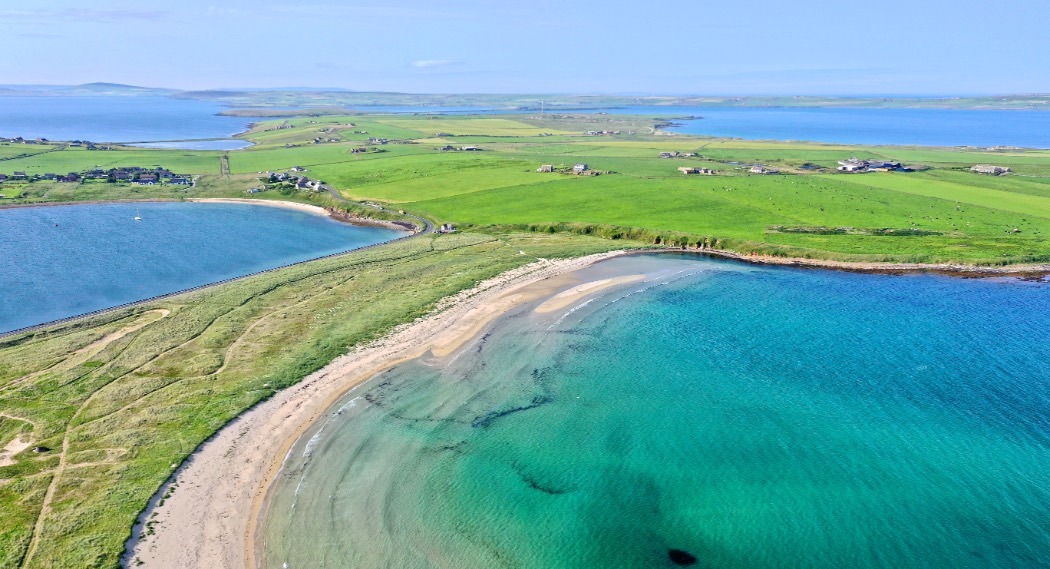

Shetland Global Geopark
Where to start
Make the first trip on your island adventure to the Shetland Museum and Archives where you can pick up information on the network of heritage and cultural sites throughout the isles and make sure you’ve got all the right stops planned for your trip.
Places to base yourself
Why it’s special
Shetland is a geological jigsaw, with rocks millions of years old that have influenced not just the physical landscape, but the culture of all the people who have lived here in that time.
These islands are home to many features of national and international significance, from the Great Glen fault to the Eshaness cliffs and the Shetland ophiolite in Unst, where two continents once collided.
Type of designation:
Geopark
How long to stay:
At least 3-4 days
What to do during your time
Things to do
Shetland Museum and Archives
Begin the story of the formation of the Shetland islands from their geological origins to the present day at Shetland Museum and Archives at Hays Dock in Lerwick. You’ll learn how the land of the geopark began its formation millions of years ago. Move through the history of Shetland’s early people, including its Viking colonisation, to how culture and society have evolved in more recent centuries.
The museum itself sits on Hay’s Dock, the last remaining area of original dock which is category B-listed. It’s a beautiful setting to highlight the heritage connection with the sea.
Visit Shetland Museum and Archives.
Mousa
Dating back 2,000 years, Mousa Broch is an Iron-age roundtower that protected its occupants from the elements and invaders alike, and is the tallest and best-preserved remaining broch tower of over 500 that were built across Scotland.
The Broch of Mousa has a long history and even appears in the Norse Sagas as a refuge on a couple of occasions. It’s now probably the easiest place to see storm petrels in the world.
Learn more about Mousa Broch.
Jarlshof Prehistoric and Norse Settlement
This site has attracted the close attention of archaeologists since it was discovered at the end of the 19th century. Jarlshof was first settled over 4,000 years ago during the Neolithic period and then inhabited repeatedly through the Iron Age, Norse settlement and Medieval times to the 17th century. The earliest remains are late Neolithic houses, followed by the Bronze Age houses, an Iron Age broch, and the most spectacular wheelhouses anywhere in Scotland – the rooves of the cells still survive today. Later a Viking farm was established which lasted for centuries.
Explore Jarlshof.
Old Scatness Broch & Iron Age Village
Originally discovered less than 50 years ago in 1975 during the construction of an airport access road, Old Scatness is a time capsule into another world. The broch and village are thought to have been occupied for around 2,000 years, beginning in the early Iron Age, and are remarkably well preserved.
The roundhouses are incredible, with diameters even greater than those of brochs but with far thinner walls. There are reconstructions here which will give you a feel for what life really was like here in the far-off past.
Take a trip to Old Scatness.
Keen of Hamar
Shetland has a unique flora of its own thanks to the isolation it enjoys. The botanical highlight of any visit is Keen of Hamar Nature Reserve on the Isle of Unst. You can find the only examples in the world of Edmondston’s Chickweed, named after Unst’s famous 19th century teenage botanist, Thomas Edmondston.
Explore Keen of Hamar Nature Reserve.
Eshaness
Follow the clifftop walk around the headland of Eshaness in Shetland. Explore the coast around the Villains of Ure, The Grind of the Navir and the Holes of Scraada, perhaps spotting otters, dolphins and even orcas along the way. In the summer months, the cliffs become hanging gardens scattered with flowers as the surging waves crash against the rocks below.
Follow the Eshaness Circular walk.
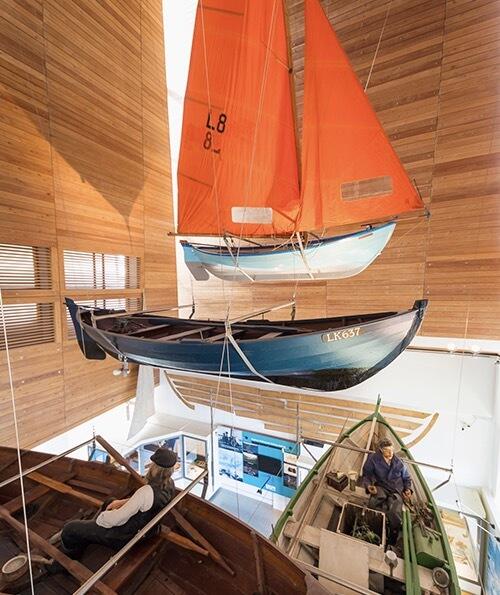
Sea tours
The sea is such a part of Shetland – no part of land is ever more than 5 km from the sea! Enjoy a hands-on kayaking adventure with Sea Kayak Shetland exploring the remote voes, wildlife and water with an experienced instructor. You could also experience the spectacular seacliffs and seabirds of the Noss National Nature Reserve, on a boat trip with Shetland Seabird Tours.
Did you know?
Shetland has the highest density of otters anywhere in Europe. Other Shetland wildlife includes seals, puffins and even orcas, humpback, sperm, minke and fin whales.
Hermaness National Nature Reserve
As Britain’s most northerly inhabited island, Unst offers an unparalleled experience. Take a coastal walk along the cliffs of Hermaness National Nature Reserve, one of the best places to see puffins up close. Unst has stunning landscapes, incredible wildlife and incredibly the highest density of rural Viking longhouses in the world.
Top tip: while on Unst, don’t miss the most famous bus stop in the world, carefully decorated inside.
Visit Hermaness National Nature Reserve.
Garths Croft, Bressay
A trip to the island of Bressay offers the truly unique opportunity to join a local crofter, who is also a professional archaeologist, on a walk through the agricultural year in Shetland. Garths Croft, on the island of Bressay, is a smallholding specialising in native and heritage breeds. You’ll see the tools and equipment used by a Shetland crofter and meet the sheep of course!
Alongside the beautiful sheep you’ll find pigs, turkeys, hens, fruit, vegetables, trees and drystone dykes, so there is plenty to see.
Visit Garths Croft.
The Old Haa, Yell
The Old Haa is a museum, garden and tearoom on the island of Yell. Hosting a collection of historic objects, and an archive alongside a programme of contemporary arts and crafts exhibitions, the museum is free and open to all.
There is an extensive sound and photographic archive in the museum containing over 16,000 images.
Explore The Old Haa.
Hoswick Visitor Centre
Located in a former Shetland tweed weaving mill the Hoswick Visitor Centre and Café is a lovely place to stop near Sandwick. Exhibits include vintage weaving machinery, knitwear and a wireless collection displaying radio equipment from the early 1900s through the decades to the mobile phone era.
The café provides excellent home bakes, light lunches, souvenirs and locally made craft work.
Take a trip to Hoswick Visitor Centre.
Foula
Foula is one of Shetland’s outer islands and has incredible geology, with five tall peaks. The most famous is Da Kame, which is the highest sheer cliff in Britain at 1,233 feet.
Da Sneck ida Smallie is an amazing 200 ft natural fissure in the rock that leads to the sea while the Gaada Stack is a unique rock formation in the north of the isle and a popular whale watching spot.
The famous Foula sheep graze the island. They’re an indigenous flock of native Shetland sheep renowned for their distinctive natural coloured fleeces. There are also plenty of wild Shetland ponies.
Explore Foula.
Food & Drink
Make sure to try some local seafood in Shetland - the sea provides an endless source of inspiration for restaurants across the isles. Taste some succulent smoked salmon at Busta House Hotel, or try Burra crab and Yell blue mussels at Fjara Café Bar in Lerwick.
Other great Shetland produce includes lamb – the native lamb is smaller than average, but has a wonderful, distinctive flavour thanks to the grass and heather moorland, swept by salty gales. Some flocks have access to the shore and seaweed forms part of their diet, adding another unusual note to the flavour.
Accommodation
The Busta House Hotel
The Busta House Hotel is a country house which offers an ideal mix of modern glamour and Shetland authenticity. It offers amazing views out as the sun sets - sometimes you might even be able to spot the Northern Lights, when conditions are favourable.
Book the Busta House Hotel.
Shetland Lighthouse Holidays
Enjoy Shetland from the comfort of your own personal lighthouse. Shetland Lighthouse Holidays offer visitors the opportunity to stay in one of three historical and spectacularly situated lighthouses. From the very tip of Shetland's southernmost point in Sumburgh to the dramatic North West cliffs of Eshaness and the exposed outcrop of Bressay – each location offers a unique and unforgettable holiday destination.
Book a Shetland Lighthouse.
Self-Catering Shetland
Stay in one of nine cosy self-catering apartments in Lerwick, Shetland’s capital. The Decca, on the edge of Lerwick, was Shetland's Radio Navigational Signal Station for 35 years until the early 1990s. Renovated to a beautiful standard, the building is now a perfect haven for the discerning visitor to Shetland.
Book Self-Catering Shetland.
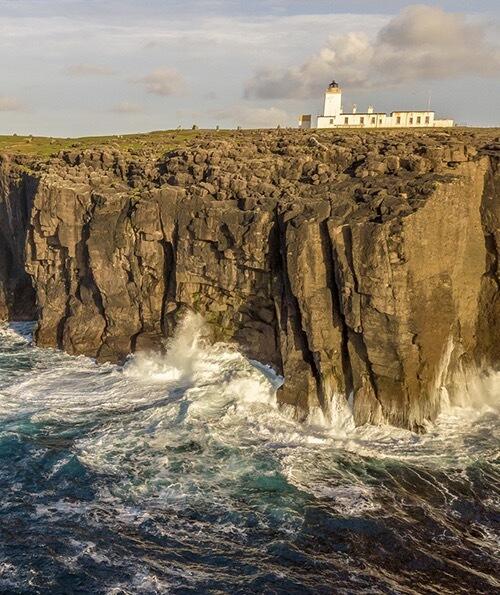
Local tips
There are lots of suggested trails and itineraries you can follow to explore Shetland – try the Volcano Trail or the Ophiolite Trail. Or look at some of the Geology Leaflets to find out more.
On the west side of Shetland, you will see the remarkable survival of prehistoric farms and field systems, as the higher land has been used lightly for grazing since prehistoric times. You’ll see the fields still clearly marked out, with remains of prehistoric round houses and field dykes (walls) which run between settlements. Read the interpretation boards at Stanydale and the Scord of Brouster.
Walks, cycle routes, ways to travel around
Follow one of Shetland’s walking routes.
Try cycling around Shetland following these routes.
More information
UNESCO designation
Shetland Geopark Shetland top archaeological sitesVisiting the area
Shetland Lerwick iCentre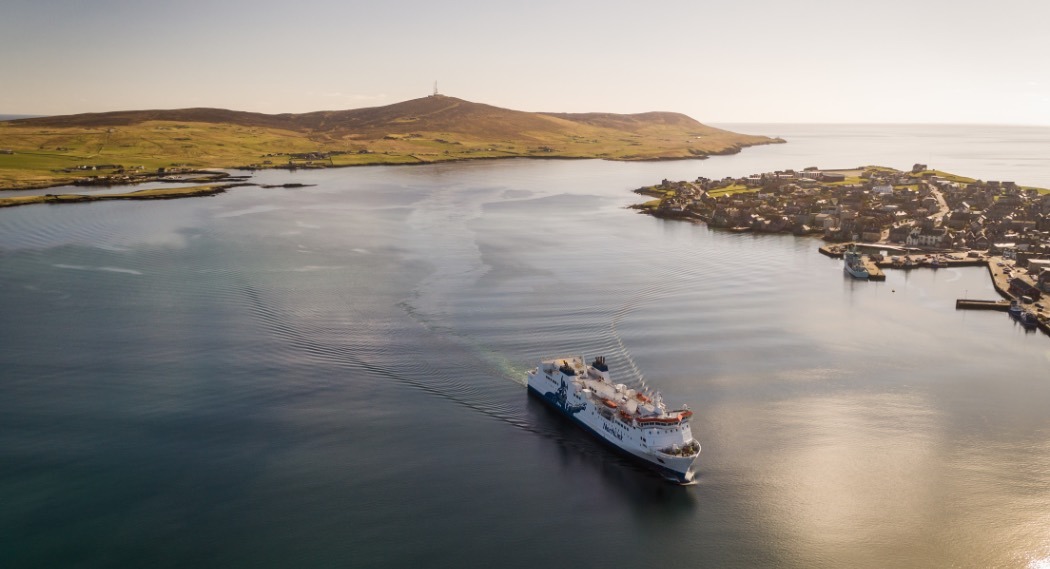
Where next on the UNESCO Trail?
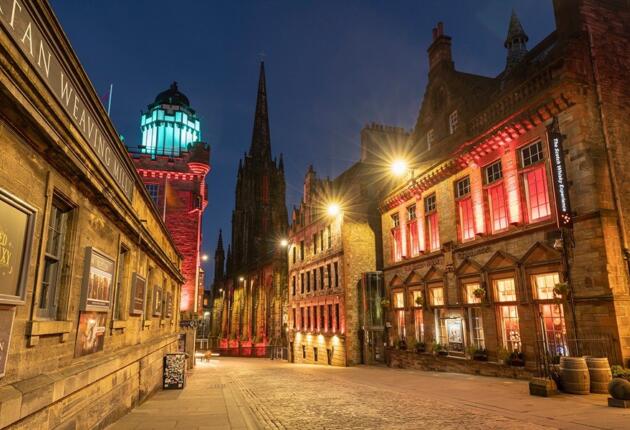
Discover & Explore the UNESCO Sites of Central East Scotland
To arrive in the east of Scotland from most places in the UK, it’s a simple case of hopping on a train from the nearest station and arriving in Edinburgh Waverley Train Station. There’s also Edinburgh Airport with connections to international hubs across the UK and Europe. From here, reach Dundee by train, or make use of excellent rail, bus, and cycle networks to explore the wider region. Find practical advice and tips on getting around the cities and the region’s UNESCO World Heritage Sites, attractions, accommodation, and places to eat.
View Journey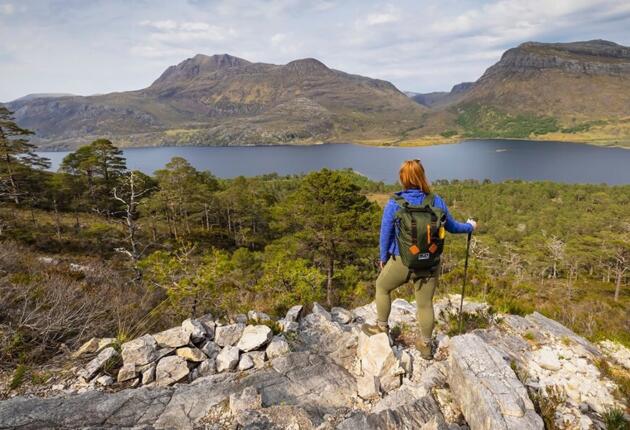
Experience the Awe-Inspiring UNESCO Sites of North Scotland
North Scotland is more accessible than you might think, with options to arrive by train or bus. This secluded part of the country has some of the world’s most scenic driving routes, and the journey around the biosphere and geopark’s communities, natural landmarks and attractions is just as spectacular as the destinations. Read our practical advice on how to get around, what to see, and where to stay and eat.
View Journey
